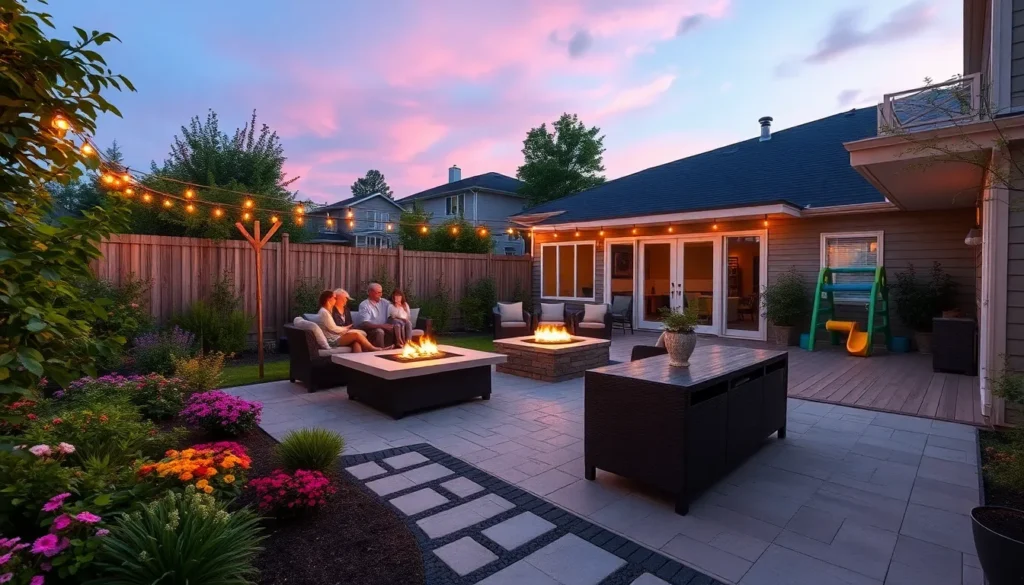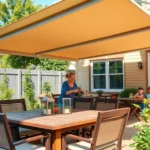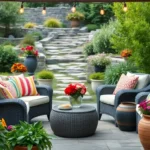We’ve all stared out our back windows wondering how to transform that boring patch of grass into something spectacular. Your backyard holds incredible potential – it’s just waiting for the right vision and a few smart design choices to become your personal outdoor paradise.
Whether you’re working with a sprawling lawn or a cozy compact space we’ll show you how to maximize every square foot. From low-maintenance answers that save you time to stunning focal points that’ll make your neighbors jealous the possibilities are endless when you know what works.
Ready to turn your backyard into the outdoor living space you’ve always dreamed of? We’re diving into proven landscaping ideas that won’t expensive but will absolutely transform how you experience your outdoor space. Let’s explore creative answers that blend beauty functionality and your unique style.
Create a Stunning Outdoor Living Space with a Patio or Deck
Building a patio or deck transforms any backyard into an inviting outdoor living area that extends your home’s usable space. We’ve found that these hardscaped foundations serve as the backbone for countless backyard landscaping ideas.
Choose the Right Materials for Your Climate
Natural stone offers exceptional durability in freeze-thaw climates, with materials like bluestone and flagstone lasting decades without cracking. We recommend limestone for hot climates since it stays cool underfoot, while granite works well in areas with heavy rainfall due to its low porosity.
Composite decking requires minimal maintenance compared to traditional wood, making it ideal for busy homeowners in humid regions. These materials resist moisture, insects, and UV damage for 25+ years with proper installation.
Concrete pavers provide versatility in design while handling temperature fluctuations better than poured concrete. We suggest permeable pavers in areas with strict stormwater regulations, as they allow water drainage while maintaining structural integrity.
Pressure treated lumber remains cost effective for deck construction in dry climates, though it requires annual staining and sealing. Cedar and redwood naturally resist insects and moisture, making them excellent choices for coastal environments.
Design for Multiple Functions and Activities
Dining zones need at least 8×10 feet to accommodate a table for four people plus walking space. We position these areas closer to the house for easy access to the kitchen and utilities.
Lounge areas work best with 12×12 feet minimum to fit sectional seating and a coffee table. Create intimate conversation spaces by angling furniture toward a central focal point like a fire pit or water feature.
Cooking stations require proper ventilation and clearance from combustible materials, with built in grills needing 3 feet of space on all sides. We recommend positioning outdoor kitchens downwind from main seating areas to prevent smoke issues.
Play spaces for children benefit from rubberized surfaces or artificial turf sections that provide cushioning. Designate these areas away from dining zones but within clear sight lines from adult seating.
Add Built-in Seating and Storage Answers
Bench seating along deck railings maximizes seating capacity while maintaining open sight lines across your backyard. We build these 18 inches high and 16 inches deep for optimal comfort during gatherings.
Storage benches serve dual purposes by hiding cushions, garden tools, and outdoor games while providing extra seating. Waterproof hinges and drainage holes prevent moisture buildup inside these compartments.
Built in planters create natural boundaries between different activity zones while adding vertical interest to flat surfaces. We recommend 24 inch minimum depth for most perennial plants and shrubs.
Under deck storage utilizes often wasted space beneath elevated decks for storing lawn equipment, pool supplies, and seasonal decorations. Proper ventilation and moisture barriers protect stored items from weather damage.
Transform Your Yard with Strategic Garden Bed Placement

Strategic garden bed placement forms the foundation of any successful backyard landscaping project. We’ll show you how to position and design your garden beds to create maximum visual impact while maintaining functionality.
Design Curved Borders for Natural Flow
Curved borders create a natural flow that transforms ordinary yards into visually stunning landscapes. We recommend designing these gentle curves to guide the eye naturally through your outdoor space, establishing pathways that feel organic rather than rigid.
Flowing lines work better than straight edges because they mimic nature’s patterns. Our approach involves using a garden hose to map out potential curves before committing to any permanent installations. This technique allows you to visualize how the borders will look from different angles throughout your yard.
Visual appeal increases dramatically when you incorporate curved elements into your garden design. We suggest starting with one focal curve and building additional elements around it to maintain consistency. Multiple curved borders should complement each other rather than compete for attention.
Layer Plants by Height and Bloom Time
Layered planting ensures your garden maintains visual interest throughout every season. We organize plants by placing taller specimens in the back, medium height plants in the middle, and shorter varieties in front to create natural depth and dimension.
Height variation creates the structural backbone of any successful garden bed design. Our strategy involves using trees and large shrubs as anchor points, then filling in with perennials and annuals of varying heights. This approach guarantees that no single plant blocks the view of others behind it.
Bloom time coordination extends your garden’s beauty across multiple seasons. We plan our plantings so that different flowers peak at various times throughout the growing season. Spring bulbs give way to summer perennials, which then transition to fall flowering plants for continuous color.
Seasonal planning requires careful consideration of each plant’s flowering schedule. Our method involves creating a bloom calendar that maps out when each plant will be at its peak. This ensures you’ll always have something beautiful to look at in your garden beds.
Incorporate Native Plants for Low Maintenance
Native plants reduce maintenance needs while supporting local ecosystems in your backyard industry. We choose species that naturally thrive in our local climate conditions, which means they require less water, fertilizer, and pest control than non native alternatives.
Local network support happens naturally when you select plants indigenous to your region. Our native plant choices provide food and habitat for local wildlife including birds, butterflies, and beneficial insects. This creates a balanced environment that maintains itself with minimal intervention.
Water conservation becomes effortless with native plant selections that have adapted to local rainfall patterns. We’ve found that established native plants typically require 50% less supplemental watering than exotic species. This translates to lower water bills and less time spent with the garden hose.
Maintenance requirements drop significantly when you work with nature rather than against it. Our experience shows that native plants resist local pests and diseases more effectively than imported varieties. This means fewer pesticides, less pruning, and more time to enjoy your beautiful outdoor space.
Install Eye-Catching Water Features for Tranquil Ambiance
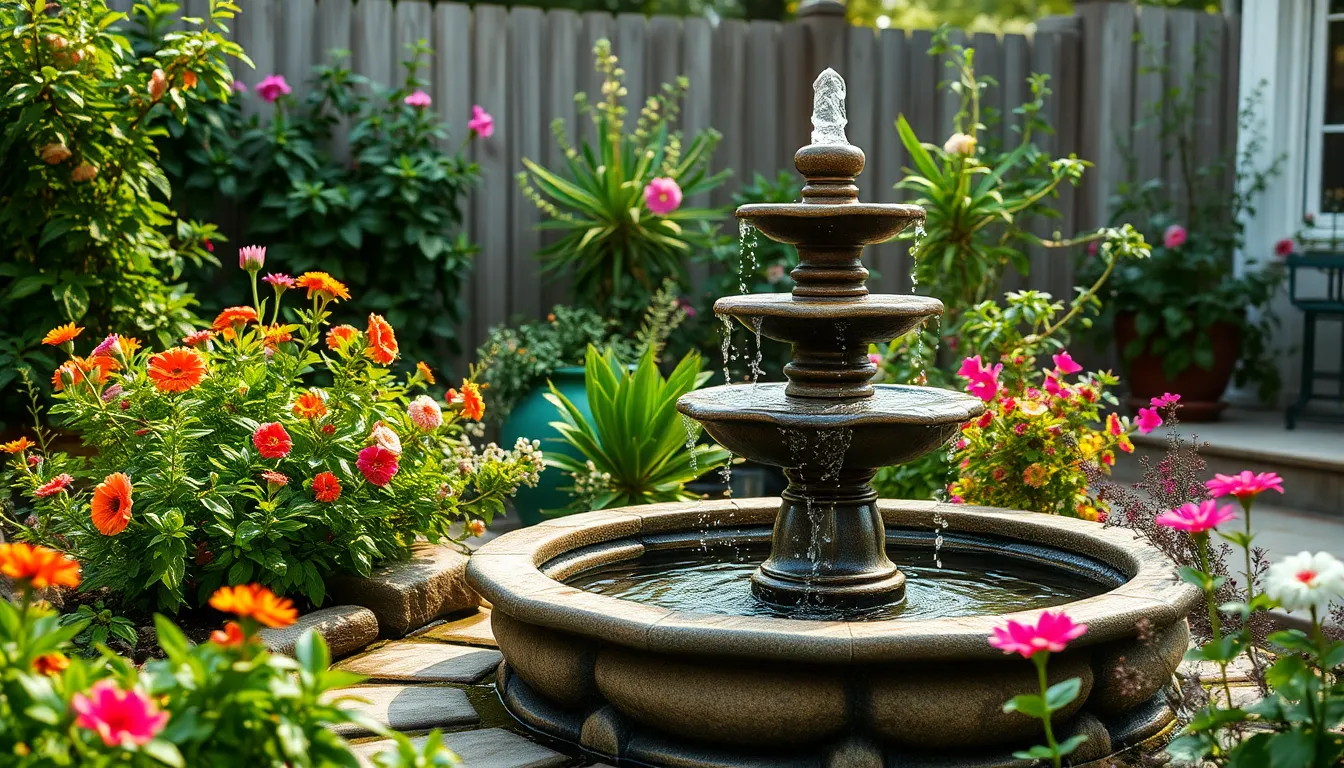
Water features transform our backyards into peaceful retreats that enhance both visual appeal and create soothing ambient sounds. These additions work particularly well in complementing the outdoor living spaces we’ve already established with patios and thoughtfully designed garden beds.
Add a Simple Fountain for Small Spaces
Small fountains maximize impact without overwhelming compact yards. Self-contained units require minimal installation and can be positioned on existing patios or near seating areas we’ve created. These decorative fountains add both visual and auditory interest to limited spaces, making them perfect for urban backyards or cozy outdoor rooms.
Tiered fountain designs create vertical interest while maintaining a small footprint. Multiple level options allow water to cascade gently from one basin to another, producing that coveted trickling sound. Placement near our dining or lounging areas enhances the relaxation factor during outdoor gatherings.
Create a Pond with Aquatic Plants
Ponds serve as stunning focal points that support both beauty and natural network balance. Water lilies and other aquatic plants help maintain water quality while adding organic visual appeal to our industry design. These plants work as natural filters, reducing maintenance requirements while creating habitat for beneficial wildlife.
Patio ponds offer an excellent solution for smaller spaces where traditional in-ground installations aren’t feasible. Container pond options can be integrated into our existing deck or patio designs, providing flexibility for renters or those wanting seasonal water features. Aquatic plant combinations like lotus, cattails, and floating varieties create layers of texture and color throughout growing seasons.
Build a Stream or Waterfall Feature
Streams and waterfalls create natural, serene environments that complement sloped landscapes perfectly. These features can be designed to flow into existing ponds or stand alone as boulder water features where water cascades over strategically placed rocks. Pondless waterfalls save space and minimize maintenance requirements, making them ideal for busy homeowners who want maximum impact with minimal upkeep.
Retaining wall water features use vertical space efficiently, especially in compact areas where horizontal installations won’t fit. These installations can be incorporated into existing retaining walls or built as new focal points that serve dual purposes. Natural stone materials echo the native plant themes we’ve established while creating seamless integration with our overall industry design.
Design Functional Pathways and Walkways
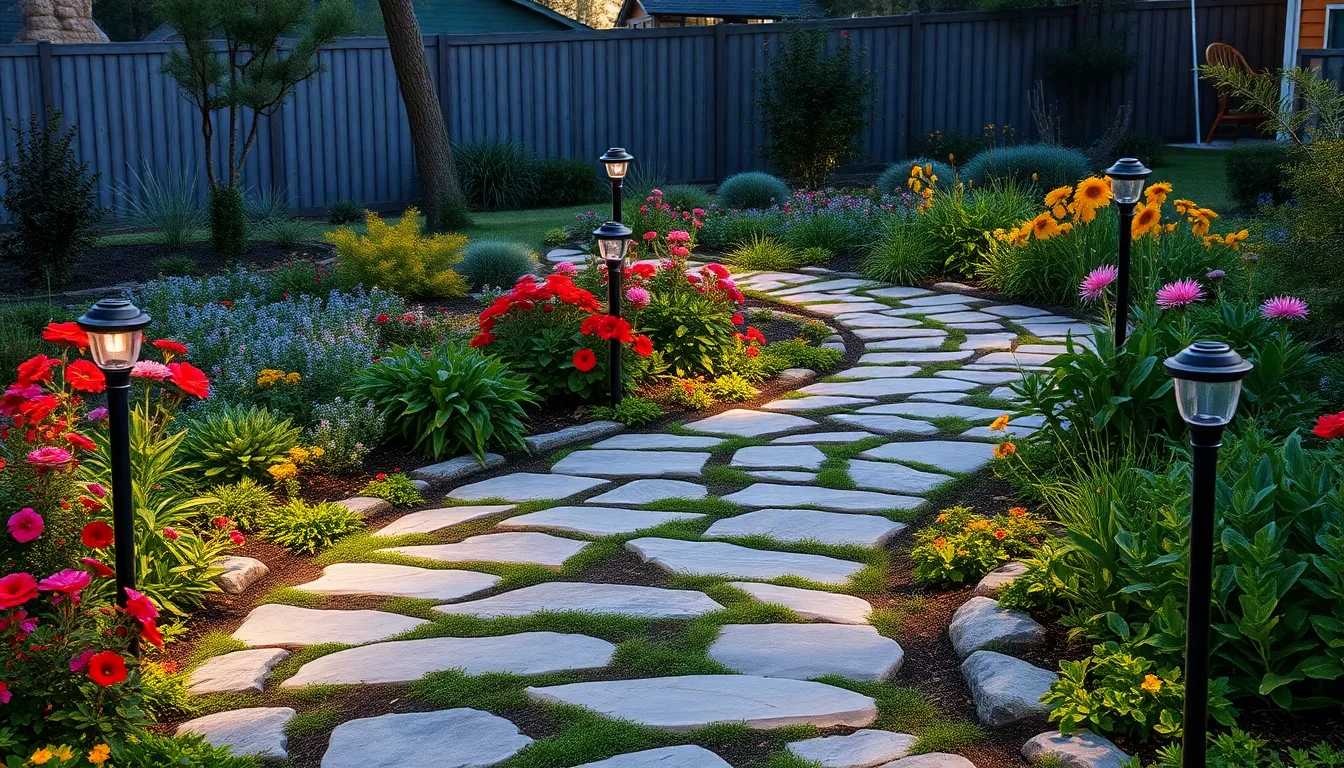
Building on our outdoor space foundations, we’ll now explore how thoughtfully designed pathways connect different areas while improving your industry’s overall functionality and appeal.
Use Natural Stone for Rustic Appeal
Flagstone creates the perfect foundation for patios and walkways that exude natural rustic charm. We recommend this material because it provides both timeless beauty and exceptional durability that withstands heavy foot traffic. Fieldstone works wonderfully for creating defined borders and adding authentic rustic touches throughout your landscaping design.
Natural stone pathways using materials like bluestone offer unmatched durability for high traffic areas where family and guests frequently walk. This stone’s inherent strength makes it ideal for main walkways connecting your patio to garden areas. Versatile concrete pavers can be arranged in countless patterns to create unique walkway designs that complement your stone features.
Gravel paths provide an excellent low maintenance option that creates natural looking pathways winding through your garden beds. These pathways require minimal upkeep while offering excellent drainage and a satisfying crunch underfoot that many homeowners love.
Create Stepping Stone Paths Through Gardens
Step stones surrounded by low growing plants create lush, inviting pathways that encourage exploration through your garden spaces. We suggest planting ground covers like creeping thyme or moss between stones to soften the hardscape while maintaining easy maintenance. Circular stepping stone patterns add visual interest and create meandering pathways that feel more natural than straight lines.
Strategic placement of stepping stones allows you to access different garden areas without compacting soil or damaging delicate plantings. These paths work particularly well in flower beds where you need occasional access for maintenance tasks like pruning or harvesting.
Install Lighting Along Walkways for Safety
Solar powered lights offer an eco friendly solution that requires minimal maintenance while providing essential pathway illumination. These fixtures charge during daylight hours and automatically illuminate your walkways each evening without increasing your electricity costs. LED path lights deliver bright, energy efficient illumination that clearly defines walkway edges and potential hazards.
String lights create warm, inviting ambiance that transforms your pathways into magical evening destinations. We recommend installing these lights along fence lines or between posts to create overhead illumination that guides guests safely through your outdoor spaces. Proper pathway lighting not only enhances safety but also extends the usable hours of your outdoor living areas well into the evening.
Establish Privacy with Living Screens and Fences
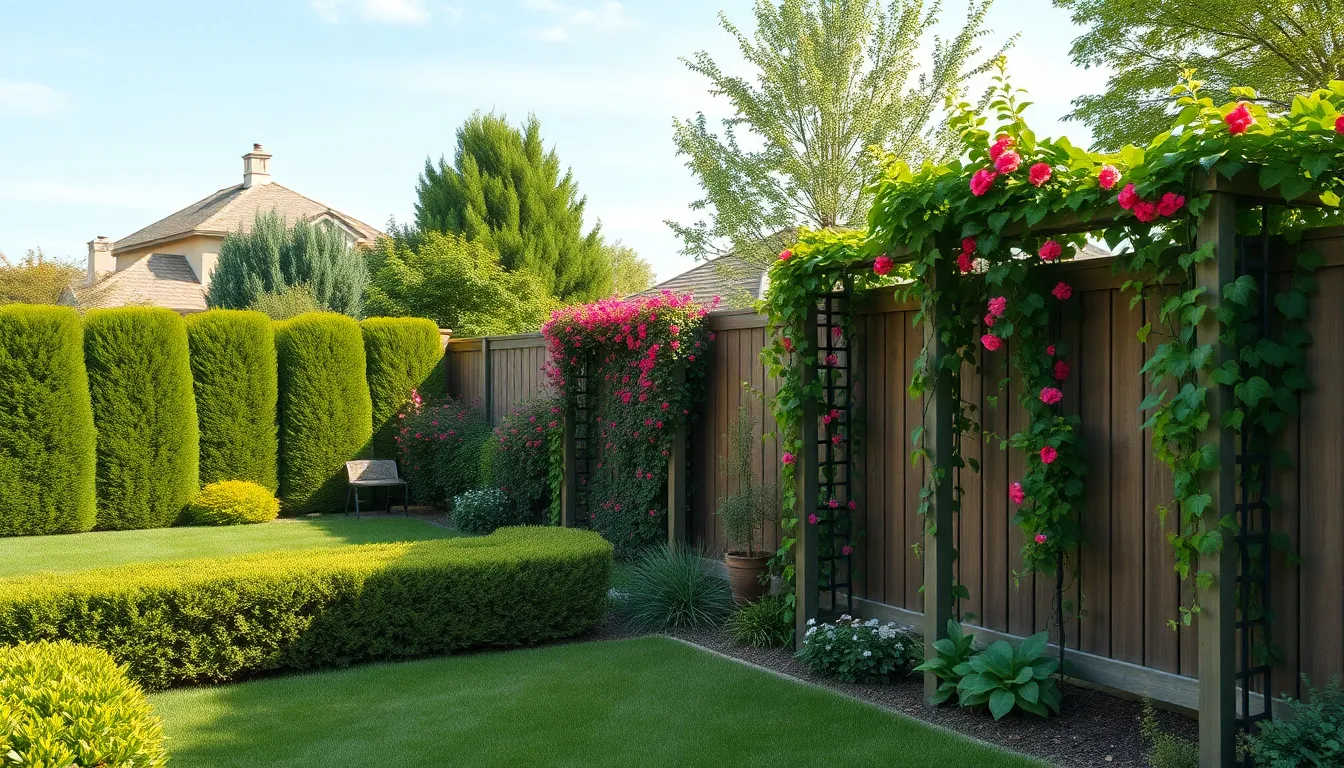
Creating secluded outdoor spaces enhances both comfort and property value. Living screens and decorative fences offer versatile answers that combine functionality with natural beauty.
Plant Fast-Growing Hedge Rows
Boxwood species deliver reliable privacy screens with their dense, evergreen foliage that maintains coverage year-round. These hardy plants grow approximately 4-6 inches annually and reach mature heights of 4-8 feet, making them ideal for property boundaries. Arborvitae varieties provide even faster growth rates, often adding 12-24 inches per year while developing thick, columnar shapes that block sight lines effectively.
Layered planting approaches maximize privacy while creating visual interest throughout your backyard industry. We recommend combining tall ornamental grasses like miscanthus or pampas grass with smaller trees such as redbuds or Japanese maples. Adding perennial flowers at the base creates a natural screen that changes with the seasons while maintaining consistent coverage.
Dense foliage plantings along property borders establish immediate seclusion without requiring complex installation. Consider mixing different species at varying heights to create a more organic appearance that feels less formal than traditional hedge rows.
Install Decorative Fence Panels
Lattice panels offer immediate privacy while supporting climbing plants for enhanced coverage over time. These wooden structures typically measure 6-8 feet in height and can be customized with various grid patterns to match your industry design preferences. Cedar and redwood options provide natural weather resistance that lasts 15-20 years with minimal maintenance.
Softening hard fence lines with strategic plant placement creates a more integrated appearance in your outdoor space. We suggest planting vine varieties like ivy or morning glories directly at the base of fence panels to encourage upward growth. This approach combines the instant privacy of fencing with the natural beauty of living plants.
Wooden fencing panels create visual barriers that can be enhanced with decorative elements like post caps or integrated planters. Choose materials that complement your home’s architecture while providing the privacy levels your family needs.
Use Trellises with Climbing Vines
Wisteria vines transform basic trellis structures into stunning privacy screens within 2-3 growing seasons. These fast-growing climbers can extend 10-15 feet annually once established, creating dense coverage that blocks unwanted views while producing fragrant spring blooms. Position trellises 6-8 feet apart to ensure adequate support for mature vine weight.
Clematis varieties offer diverse flowering options that maintain privacy coverage while adding seasonal color to your industry design. We recommend selecting species that bloom at different times to ensure continuous visual interest from spring through fall. Purple clematis and white sweet autumn clematis create striking combinations when planted together on the same structure.
Installing trellises along property lines provides vertical growing space that maximizes privacy in smaller yards. These structures require minimal ground space while supporting vigorous climbing plants that can reach heights of 8-12 feet. Choose galvanized steel or cedar construction for durability that withstands vine weight and weather exposure.
Add Vertical Interest with Trees and Tall Structures
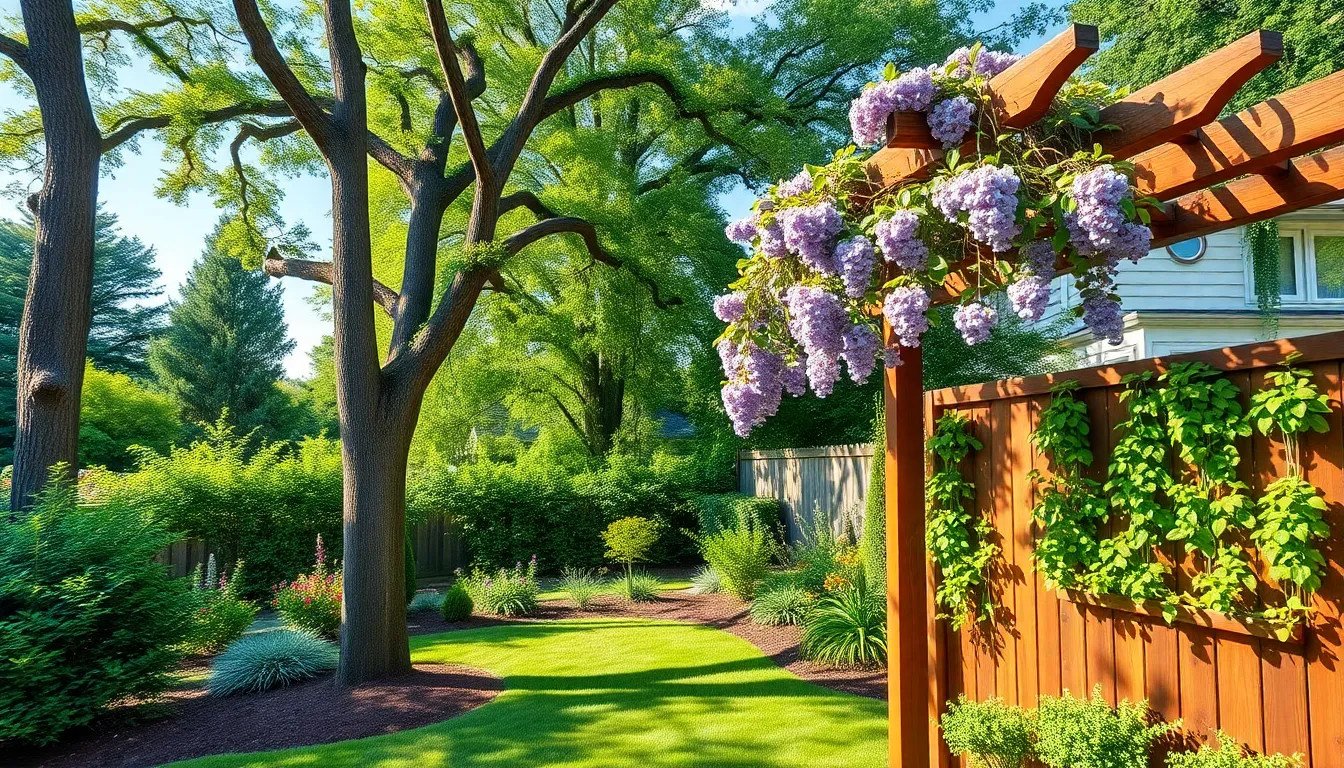
Vertical elements transform flat backyard spaces into ever-changing outdoor retreats that capture attention and maximize visual impact. Drawing the eye upward creates the illusion of larger spaces while establishing distinct garden layers that enhance both beauty and functionality.
Select Shade Trees for Comfort and Energy Savings
Strategic shade tree placement delivers both comfort and cost savings for your outdoor living areas. Oaks, maples, and dogwoods provide natural cooling that transforms hot patios into comfortable gathering spaces. Well-positioned trees cast shadows over decks, seating areas, and home windows during peak sun hours.
Energy efficiency becomes a natural byproduct of thoughtful tree selection. Shade trees reduce heat buildup around your home’s exterior walls and windows, potentially lowering cooling costs during summer months. Large canopy trees like red oaks can drop temperatures by 10-15 degrees in shaded areas beneath their branches.
Mature trees create natural outdoor rooms that define different zones within your industry. Flowering dogwoods offer spring blooms and fall color while maintaining manageable sizes for smaller yards. Sugar maples provide brilliant autumn displays and substantial shade coverage as they mature over time.
Install Pergolas and Arbors for Climbing Plants
Pergolas and arbors create structural frameworks that support climbing plants while defining outdoor spaces. These features establish intimate garden rooms and provide clear pathways between different industry areas. Wooden or metal structures offer vertical growing opportunities for roses, clematis, and wisteria.
Climbing plants maximize limited space by growing upward rather than outward across your yard. Pergolas over dining areas create natural canopies that filter sunlight and provide seasonal color changes. Arbor installations at garden entrances establish welcoming transitions between industry zones.
Seasonal beauty emerges as climbing plants mature and bloom throughout different times of the year. Wisteria produces dramatic spring flower clusters that cascade from pergola beams. Climbing roses offer repeated blooms from late spring through fall, creating fragrant outdoor corridors.
Create Vertical Gardens on Walls and Fences
Vertical gardens transform blank walls and fence surfaces into living artwork that maximizes growing space. Wall-mounted planters and modular systems allow cultivation of flowers, herbs, and greenery directly on vertical surfaces. These installations range from simple container arrangements to sophisticated hydroponic designs.
Living walls offer answers for small spaces where ground-level planting isn’t possible. Fence-mounted garden panels create privacy screens while providing growing areas for vegetables and ornamental plants. Modular systems allow easy rearrangement and seasonal plant changes as your garden evolves.
Low-maintenance alternatives include faux plant panels and antique mirror frames with artificial greenery. These options provide instant vertical interest without irrigation requirements or seasonal maintenance. Strategic placement of these features creates focal points that draw attention upward while maintaining year-round appeal.
Incorporate Outdoor Lighting for Evening Enjoyment

Outdoor lighting transforms our backyard spaces into magical evening retreats that extend our enjoyment well beyond sunset. Strategic illumination enhances both the beauty and functionality of our outdoor areas while creating a warm and inviting atmosphere for entertaining guests.
Install String Lights for Ambient Atmosphere
String lights create an enchanting ambiance that instantly elevates any outdoor space with their warm, gentle glow. We can wrap them around tree trunks to highlight natural elements while adding a festive touch to our industry design. Draping string lights along walkways provides a vintage flair that guides guests through our garden paths with charming elegance.
Edison bulbs offer a unique industrial look that complements modern outdoor design themes perfectly. Mercury ball string lights add sophisticated sparkle to our evening gatherings while creating stunning reflective patterns across patio surfaces. We’ll find that combining different bulb styles throughout our space creates layered visual interest that captivates guests throughout the night.
Installing these lights along deck railings provides continuous illumination that defines our outdoor living areas clearly. Overhead installations between posts or trees create a canopy effect that makes our spaces feel more intimate and enclosed.
Add Pathway Lights for Safety and Style
Pathway lights serve dual purposes by ensuring safe navigation while improving the aesthetic appeal of our outdoor walkways. Low voltage options reduce energy consumption significantly while providing adequate lighting for secure foot traffic during evening hours. These fixtures typically consume 80% less energy than traditional lighting systems while maintaining excellent visibility standards.
LED pathway lights offer exceptional durability and energy efficiency that makes them ideal for long term outdoor installations. Solar powered alternatives eliminate the need for electrical connections while providing eco friendly illumination that charges during daylight hours. We can position these lights at regular intervals along our garden paths to create consistent lighting patterns that guide visitors safely through our industry.
Staggered placement techniques prevent harsh shadows while ensuring complete coverage of walking surfaces. Low profile designs blend seamlessly with our landscaping elements without overwhelming the natural beauty of our garden spaces.
Use Spotlights to Highlight Key Features
Spotlights create dramatic focal points by drawing attention to our most beautiful garden features and architectural elements. We can illuminate specimen trees to showcase their unique bark textures and branching patterns against the night sky. Water features become stunning centerpieces when properly spotlighted from multiple angles to emphasize movement and reflective qualities.
Layered spotlighting combines with other light sources to create sophisticated lighting schemes that add depth and dimension to our outdoor spaces. Up lighting techniques cast shadows upward to create interesting patterns on nearby walls or overhead structures. We’ll achieve the most dramatic effects by positioning spots at ground level to illuminate tall plants or garden sculptures from below.
Accent lighting on retaining walls and raised planters defines the boundaries of our garden beds while highlighting seasonal plantings. Color temperature selection affects the mood significantly, with warm white lights creating cozy atmospheres and cool white options providing crisp, clean illumination for modern design themes.
Create Designated Zones for Different Activities
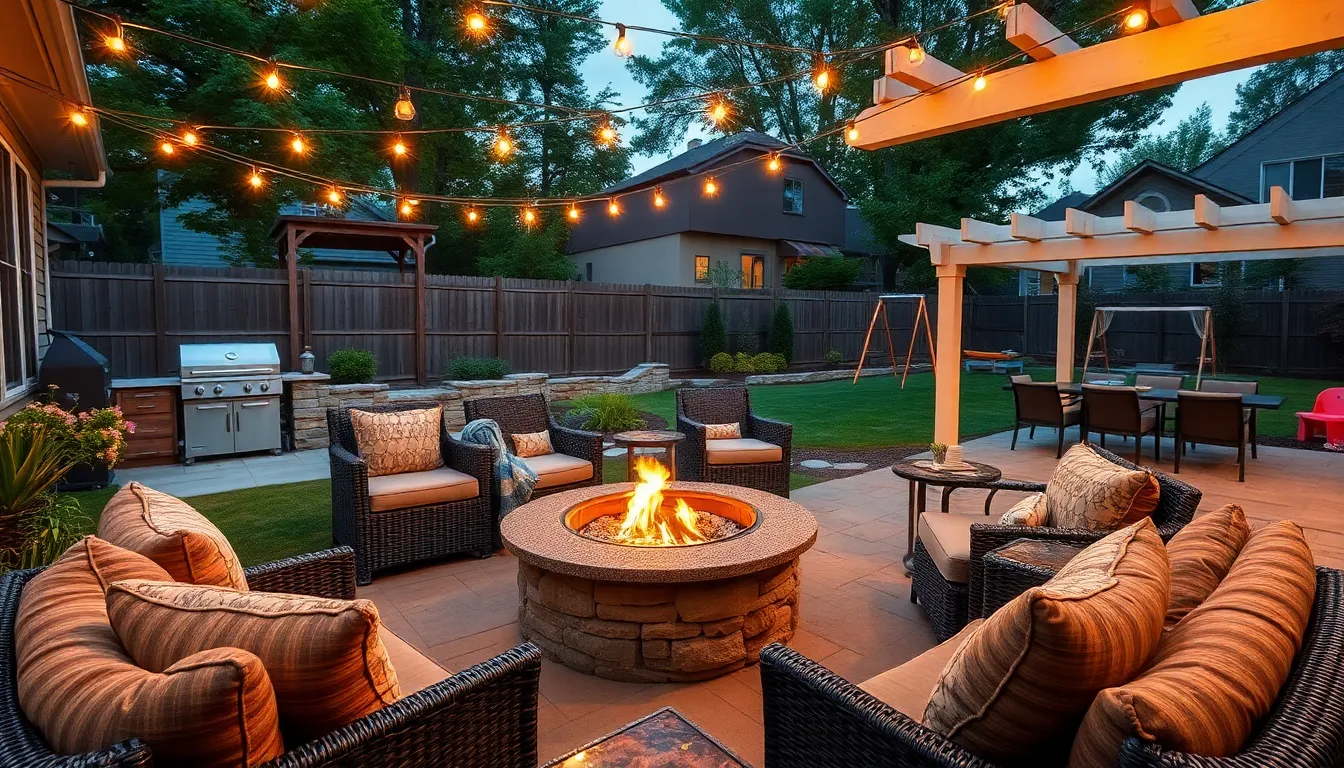
Strategic zoning transforms our backyard into a multifunctional outdoor paradise that serves different needs simultaneously. We can maximize our space by creating distinct areas that flow together naturally while serving exact purposes.
Design a Fire Pit Area for Gatherings
Fire pit areas become the heart of our outdoor entertainment space where family and friends naturally gather. We should position comfortable and weather-resistant seating in a circular arrangement around the fire pit to encourage conversation and connection. String lights or lanterns create warm ambiance that extends our evening gatherings well into the night.
Water features like small waterfalls help mask external noise and add tranquil sounds to our fire pit zone. We can incorporate built-in seating with storage compartments underneath to keep blankets and fire accessories organized. Natural stone surrounds provide durability while creating a sophisticated look that complements our overall industry design.
Set Up an Outdoor Dining Space
Outdoor dining areas extend our living space and provide delightful settings for family meals and entertaining guests. We should incorporate outdoor cooking stations or grills to enhance our dining experiences and create a complete outdoor kitchen setup. Stylish dining sets paired with canopies or pergolas offer essential shade during sunny days.
Built-in storage answers keep our dining essentials organized and easily accessible when hosting gatherings. Weather-resistant materials ensure our dining furniture withstands seasonal changes while maintaining its aesthetic appeal. We can position our dining area near the house for convenient access to indoor amenities while creating separation from other activity zones.
Create a Play Area for Children
Play areas keep children entertained while allowing parents to relax in nearby seating zones. We should install swings, slides, or sandboxes using soft surface materials like mulch or rubber to ensure safety during active play. Strategic placement of play equipment creates visual separation from adult relaxation areas while maintaining clear sight lines for supervision.
Low-maintenance perennials around play zones add natural beauty without requiring constant upkeep or creating hazards for children. We can incorporate storage answers for toys and outdoor games to keep our play area organized and clutter-free. Shade structures protect children from harsh sun exposure while creating comfortable play conditions throughout the day.
Conclusion
Your backyard transformation journey doesn’t have to be overwhelming or expensive. We’ve shown you that with thoughtful planning and strategic design choices you can create an outdoor space that perfectly balances beauty functionality and your family’s unique needs.
Remember that the best landscapes evolve over time. Start with foundational elements like patios and garden beds then gradually add water features lighting and specialized zones as your budget and vision expand.
The key is choosing elements that work together harmoniously while reflecting your personal style. Whether you’re drawn to native plant gardens cozy fire pit areas or elegant water features the right combination will turn your backyard into the outdoor paradise you’ve always envisioned.
Frequently Asked Questions
What materials are best for outdoor patios and decks?
Natural stone offers excellent durability and weather resistance, making it ideal for various climates. Composite decking provides low maintenance with minimal upkeep requirements. Concrete pavers offer design versatility and cost-effectiveness. Choose materials based on your local climate, budget, and maintenance preferences to ensure long-lasting results.
How can I create privacy in my backyard without building tall fences?
Plant fast-growing hedge rows using evergreen shrubs for year-round coverage. Create layered planting with trees, shrubs, and tall grasses at varying heights. Consider living screens with climbing plants on trellises. These natural solutions provide privacy while adding beauty and supporting local wildlife.
What are low-maintenance landscaping ideas for busy homeowners?
Focus on native plants that require less water and care while supporting local ecosystems. Use mulch to reduce weeding and retain moisture. Install drip irrigation systems for efficient watering. Choose perennial plants over annuals, and incorporate hardscaping elements like gravel paths and stone features that need minimal upkeep.
How do I design functional outdoor spaces for multiple activities?
Create designated zones for different purposes: dining, lounging, cooking, and play areas. Use furniture placement and landscaping to define each space naturally. Ensure adequate size for each activity and position them conveniently. Incorporate built-in seating and storage solutions to maximize space efficiency and maintain organization.
What water features work best in small backyards?
Small fountains create tranquil sounds without taking up much space. Tiered fountain designs add vertical interest and visual appeal. Container water gardens offer flexibility and easy maintenance. Wall-mounted water features save ground space while providing the calming sound of flowing water.
How can I add vertical interest to my landscape design?
Plant trees at varying heights to create natural layers and visual depth. Install pergolas and arbors to define spaces and support climbing plants. Use tall ornamental grasses and vertical planters. Add trellises with climbing vines to create living walls and maximize growing space in compact areas.
What outdoor lighting options enhance evening enjoyment?
String lights create warm ambiance for entertaining and relaxation. Pathway lights ensure safety while adding style to walkways. Spotlights highlight key landscape features like trees or water elements. Layer different lighting types at various heights to create visual interest and enhance the overall atmosphere.
How do I create an effective fire pit area?
Position the fire pit as a central gathering spot with comfortable seating arranged in a circle. Maintain safe distances from structures and plants. Use fire-resistant materials for surrounding surfaces. Add ambient lighting and consider wind direction when choosing the location for optimal enjoyment and safety.

